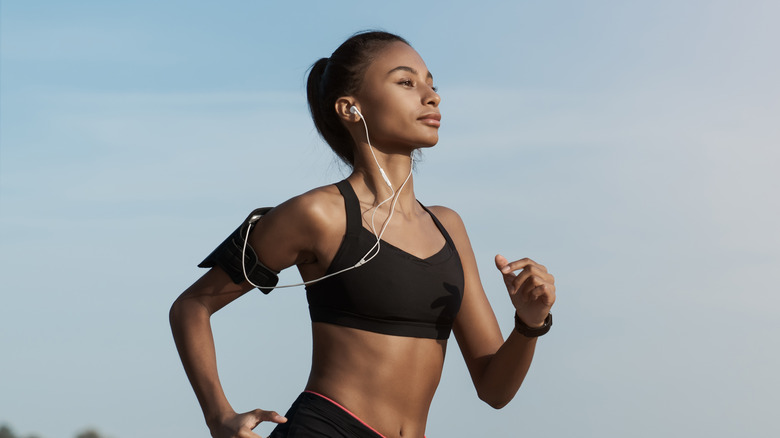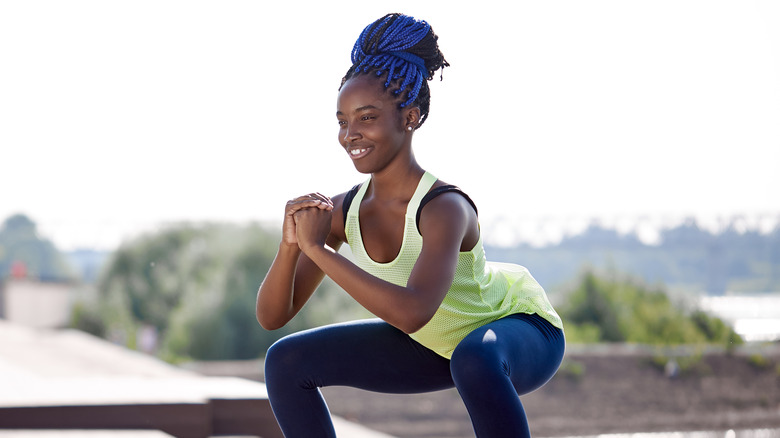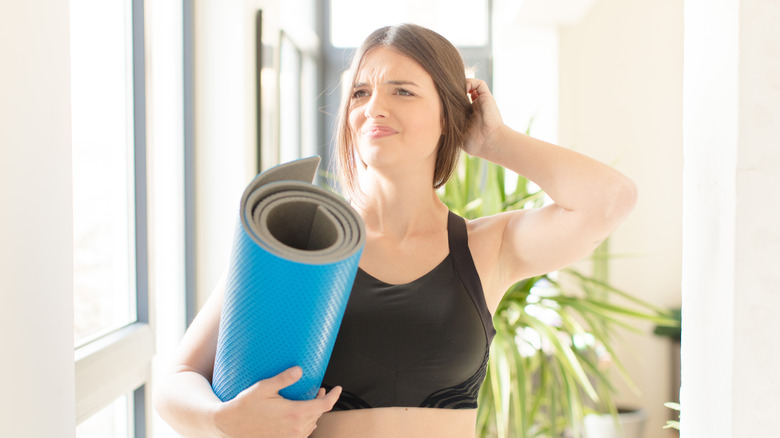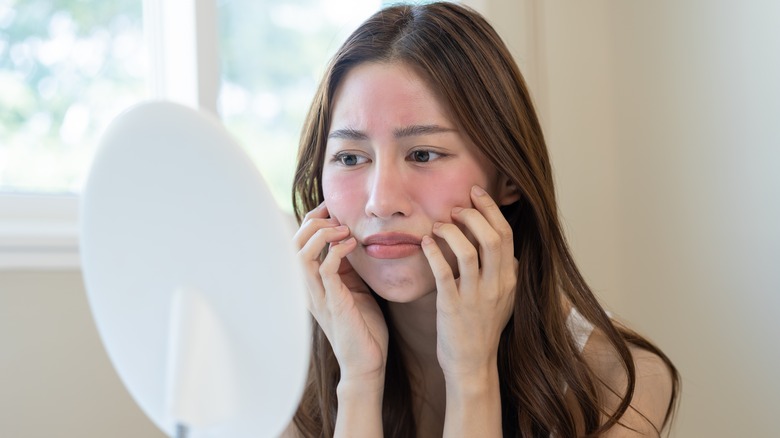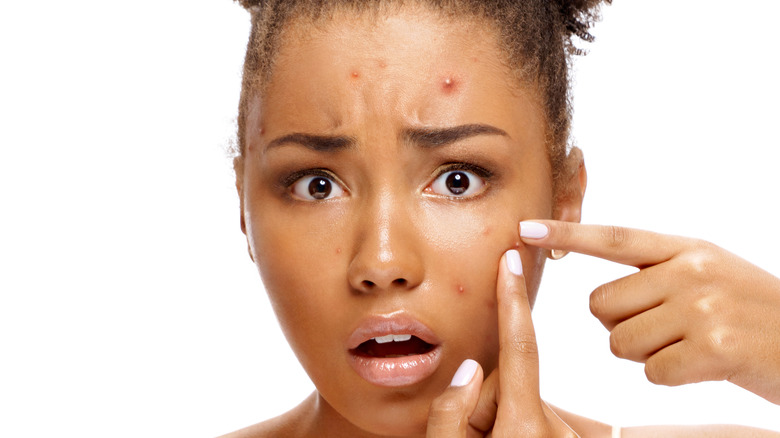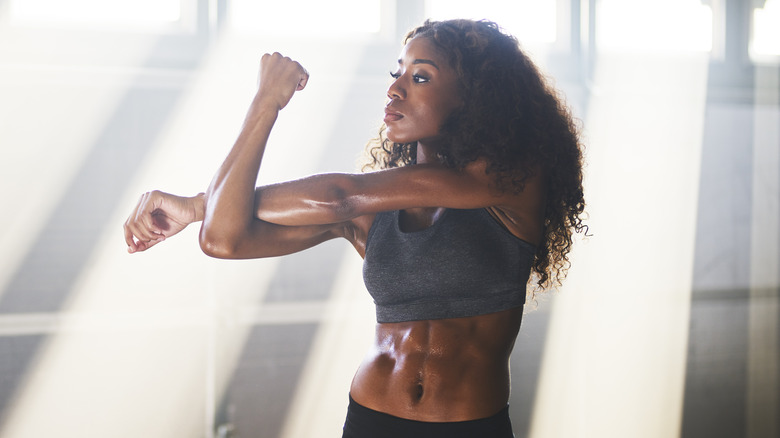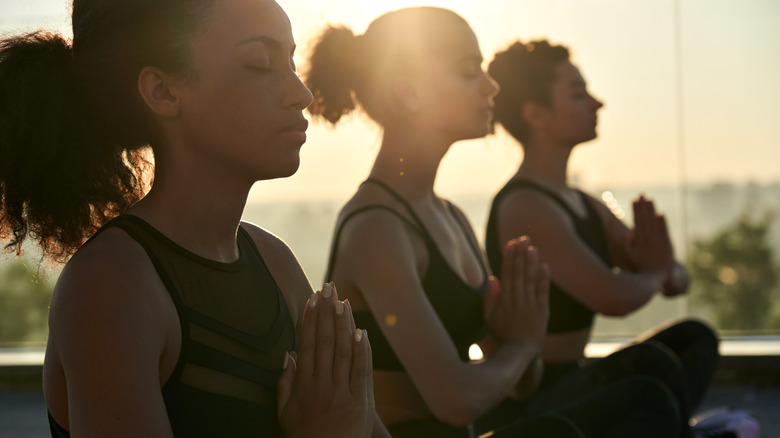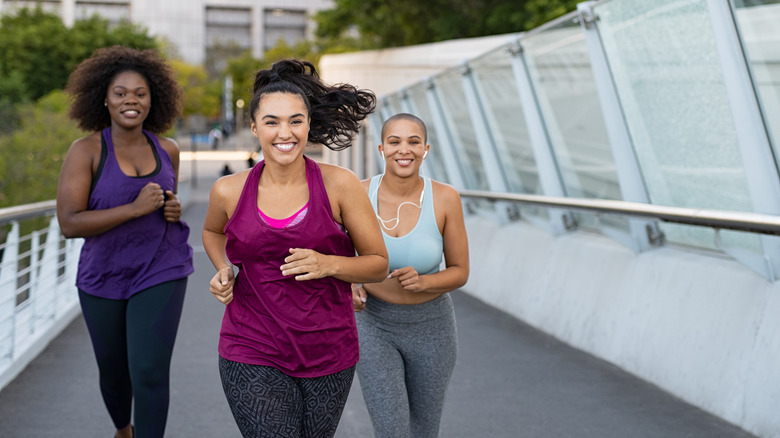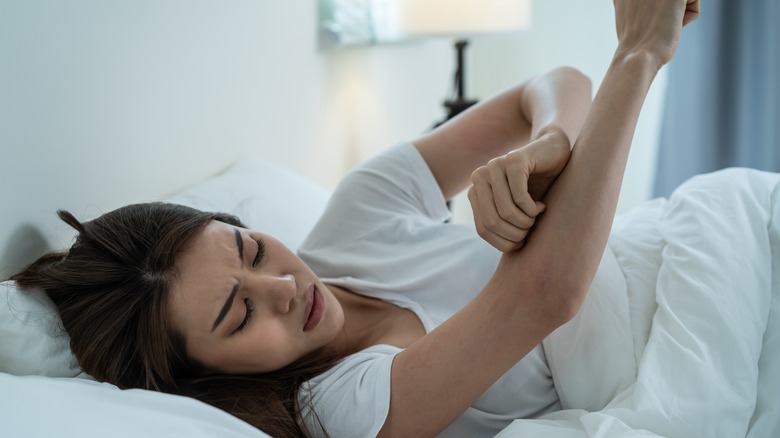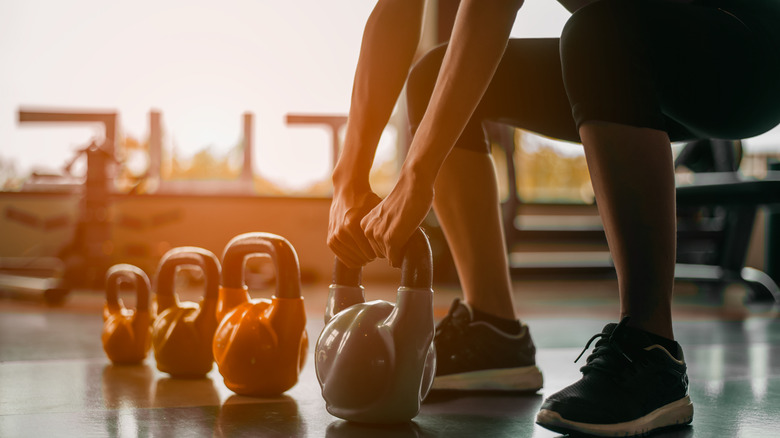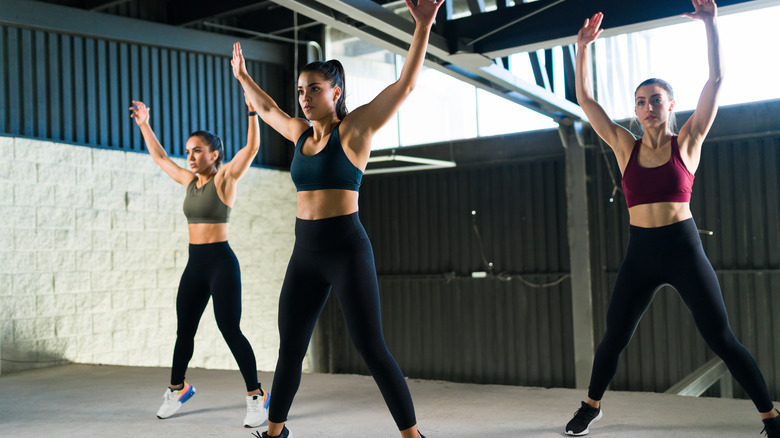10 Sneaky Ways Your Workout Can Mess With Your Skin
We all pretty much know by now that exercise is incredibly good for our bodies, not to mention that it serves as an excellent tool when we need a mental health boost.
The benefits of working out are practically being shouted from the rooftops by personal trainers on social media, and these days a good workout is just a click away on YouTube. It would be logical to assume that, since working out regularly is so good for your body, it must be good for your skin, too. You might even have heard about some of the benefits: It can give collagen production a boost, which can make look younger, and it can increase the amount of oxygen that flows to your skin — better known as that post-workout glow (via Byrdie). But if you've suddenly found yourself with more skin issues after starting a workout regimen, it's likely not a coincidence.
As it turns out, while exercise is mostly beneficial, there are also times when it can cause your skin to freak out a little. Don't get us wrong, you should definitely not stop exercising, but there are a few precautionary steps you can take to ensure that your skin stays happy while you do it. Here's a look at 10 sneaky ways your workout can mess with your skin, and how you can prevent them from happening.
Exercising outside could expose your skin to damaging UV rays
There's nothing more refreshing than going for a run outside or doing your weightlifting session in the park. While all that fresh air and exercise are incredibly good for your body, your skin might be suffering in silence.
Dermatologist Marisa Garshick told Insider that it's vital to cover every inch of exposed skin with sunscreen before heading outside to exercise, preferably one that has an SPF of 30 or higher. Depending on how long you'll be outdoors, remember to reapply SPF every two hours to ensure continued protection. Using water-resistant sunscreen can also be beneficial when exercising outside because it will be more resistant to sweat and offer longer-lasting protection. Garshick cautions that you should choose facial sunscreen carefully. SPF that contains oil and is not water-resistant is likely to clog your pores, so read the labels before you buy.
According to research from the National Institutes of Health, frequently exercising in the sun can also lead to premature aging as well as skin cancer. NIH states that it's best to do your workout either before 10 a.m. or after 4 p.m. so you don't catch the most intense sun rays. Exposing your skin to extra heat can also cause sun spots, as celebrity esthetician Renée Rouleau told Byrdie.
Your workout could mess with your scalp
We tend to forget about the parts of our skin we don't see every day, and most of us don't spend a ton of time analyzing our scalps. However, if you start noticing flakes in your hair after starting a workout regimen, it's time to pay some attention.
As strange as it might seem, it's common for your workout to affect your scalp. Speaking to Self, dermatologist Yoon-Soo Cindy Bae, MD, said that sweat can really mess with the skin on your head. "By not properly washing, sweat can cause yeast to build up and subsequently lead to the development of dandruff and irritation," she cautioned. An oily scalp is the perfect breeding ground for Malassezia, which is the main cause of dandruff.
In addition to dandruff, Dendy Engelman, MD, told Greatist that your workout could also cause scalp acne. If you're thinking this means you must wash your hair after every single workout, hold your horses: Washing your hair too much can also cause problems, like greasy hair. Engelman suggests using dry shampoo between washes.
Working out can exacerbate skin conditions like rosacea
As if rosacea isn't already pesky enough, workouts can make it flare up.
Dermatologist Sonya Johnson, MD, told Livestrong that exercising causes the blood vessels to expand — the medical term for this is vasodilation. While this process is what causes rosacea flare-ups, it also has plenty of benefits. "This increased blood flow ups the supply of oxygen to your skin and nourishes skin cells by carrying nutrients to repair damage from the sun and environment," Johnson explained. This very process is responsible for that amazing, post-workout glow, according to a book titled "Skeletal Muscle Circulation." Unfortunately, those who have rosacea tend to get a dose of inflammation along with that glow — and all the extra body heat generated during a workout can also trigger a flare-up, per Livestrong.
It might seem like you can never do a workout without suffering from a flare-up, but Sonia Batra, MD, an assistant professor of dermatology at the University of Southern California, has one simple trick that might help: a cool cloth. Keep it close as you exercise and apply it to your face as needed to keep your skin from getting too hot (via Livestrong). Dermatologist Ellen Marmur, MD, told WebMD that working out in a cool environment can also make a difference. You might also consider switching to a different type of exercise, like swimming, which keeps the skin cool throughout.
Exercise could cause acne breakouts
So, how exactly is your workout causing acne? Celebrity esthetician Renée Rouleau told Byrdie that you can thank your sweat glands for those bumps. "Sweat can, in fact, create an occlusion of the pores, resulting in red bumps caused by a combination of sweat and oil," she explained. We go to the gym to take care of our bodies, not to help our acne thrive. Luckily, there are a few steps you can take if you have acne-prone skin, one of which is removing your makeup before hitting that treadmill.
Dermatologist Susan Massick told Healthline that the increased blood flow to the skin during exercise results in open pores, which leaves the door wide open for bacteria and sweat to enter and wreak havoc on your skin. Adding makeup to the mix can cause sweat and bacteria to become trapped in the open pores, which leads to breakouts. You'll also want to keep your hair out of your face. Massick adds that haircare products, along with the hair's natural oils, can cause moisture to become trapped on the skin, leading to fungal growth and clogged pores.
Rouleau recommends properly cleansing your skin post-workout to prevent pesky breakouts. She suggests cleansers that contain acne-busting ingredients like salicylic acid and glycolic acid.
Your workout might cause clogged hair follicles
Nothing beats those post-workout endorphins, but clogged hair follicles might deflate your good mood pretty quickly.
Sweating is actually good for you — not only does it keep your body from overheating, but it also helps it get rid of free radicals, per Livestrong. Unfortunately, there's a downside: Sweat can also clog your hair follicles and sweat glands. This results in a condition called folliculitis. "Folliculitis can occur anywhere that is sweaty, especially areas of occlusion like the back and chest," Robin Evans, MD, explained. Sonia Batra, MD, added that those areas of the body are more prone to blocked hair follicles simply because they contain more sebaceous glands (via Livestrong).
These flare-ups tend to look like whiteheads, Sheryl Clark, MD, told Prevention. She added that workout clothes are often the culprit. Tight-fitting clothes prevent the hair follicles from breathing, so to speak, so bacteria can get trapped in them more easily. She suggests opting for loose-fitting workout clothes, and also advises against wearing workout attire more than once before washing it. "Anything you rewear will have bacteria on it," she warns.
If you currently struggle with folliculitis, Clark suggests opting for a body wash that contains bacteria-busting ingredients, like bleach. Yes, that sounds a little severe, but it works to clear it up quickly. Once the bumps clear up, she recommends using a body wash that contains glycolic acid, which will help prevent future breakouts.
Exercise can affect your skin's microbiome
You've probably heard talk of the gut microbiome, but did you know that your skin has its own microbiome as well? Having a healthy skin microbiome is one of the keys to getting that sought-after glow, but working out might mess with it if you're not careful.
So, what exactly is the skin microbiome? Sonia Batra, MD, explained it to Livestrong as follows: "The skin microbiome is an ecosystem of organisms living on your skin, including bacteria, viruses, and fungi." While it might seem odd that your skin naturally has bacteria living on it, these organisms act like a shield, protecting the skin from outside elements infection — pretty cool. What's less cool is that sweat can seriously mess with this delicate bacterial balance. This can cause an overgrowth of organisms like yeast, which can result in rashes on your body and dandruff on your scalp. Per Dr. Batra, this is more likely to happen when sweat sits on the skin for a prolonged period of time, so be sure to shower soon after your workout session to keep your skin happy and healthy.
Board-certified dermatologist Robin Evans, MD, suggests investing in a microbiome-friendly body wash. She recommends Mother Dirt's Biome-Friendly Foaming Cleanser, which is filled with good bacteria that neutralize the harmful bacteria sweat tends to spread across the body.
Your workout might cause thigh chafing
Raise your hand if you wish thigh chafing was one of those silly workout myths. Unfortunately, this is a very real issue for those who exercise. Thigh chafing is primarily caused by the skin rubbing against itself. Add sweat into the mix and you could end up with a sore patch of skin that's red with blister-like lesions (via Healthline).
If you're a runner, you've probably experienced this painful condition before, and would likely do anything to prevent it from happening again. According to Self, wearing longer biker shorts can be a big help. You can also try skincare products like the Body Glide Anti-Chafing Stick, which moisturizes your skin while keeping it friction-free.
As a long-term solution, Verywell Fit recommends opting for workout shorts that are seamless and made from sweat-wicking fabric. You can also use absorbent body powder that's talcum-free to ensure that your skin stays comfortable during your run.
Another way to prevent thigh chafing is to choose form-fitting workout leggings. While we have noted that close-fitting workout clothes could cause clogged hair follicles, anything that's too loose can end up causing chafing. The same goes for upper body gear. Just make sure to shower afterward to keep follicles and sweat glands from becoming clogged.
Exercise could dry out your skin
There's nothing more annoying than dry, itchy skin, and unfortunately, exercise might be to blame.
Our bodies lose a lot of water during a workout, and dry skin is often the result. Celebrity esthetician Renée Rouleau told Byrdie that dry skin brings with it a slew of other problems, like sending your skin cells to an early grave as well as causing clogged pores and premature aging.
Although it's important to stay hydrated during your workout, a 2018 study published in Skin Research and Technology found that there wasn't sufficient evidence to support the theory that drinking large amounts of water would improve the skin's hydration. Applying a good moisturizer after your post-workout shower will be more beneficial. "Using a lightweight moisturizer will help to retain the water in the skin," Rouleau told Byrdie.
If you're an avid swimmer, your skin is likely even more prone to dryness thanks to the high levels of chlorine found in swimming pools, skincare expert Dr. Rekha Tailor told Cosmopolitan. Dry, flaky skin is often the result — and if you already suffer from very dry skin or eczema, swimming pool water might make it worse. Tailor warns that chlorine can get into your skin cells and sap them of moisture, causing cracked skin and wrinkles. She recommends showering after swimming — and if you can tolerate a cold shower, it's better for your skin and helps your body recover faster.
You might pick up some skin infections from gym equipment
Germs are literally everywhere, and humid gyms provide the perfect environment for bacteria to thrive. Kathleen Cook Suozzi, an assistant professor of dermatology at the Yale School of Medicine, told Insider that picking up skin infections like ringworm and impetigo in the gym is pretty common. Impetigo, which is caused by sneaky bacteria that enter your body through small cuts and cause painful skin sores, is probably the worst of the two. If this makes you consider never setting foot in a gym again, take a deep breath: These minor skin infections can be easily treated with over-the-counter medicine (via Insider).
You can also take steps to prevent skin infections in the first place, James Marrotta, MD, told Shape. "Take care of the little things. Don't expose open skin [wounds] to the gym. Wash your hands with regular soap ... And shower right after your workout." Simple enough, right?
Dr. Marisa Garshick also recommends sanitizing your hands, wearing shoes when using the gym's showers, and cleaning yoga mats and gym equipment before using them (via Insider).
High-impact workouts can cause skin sagging
High-impact workouts are great for when you want an intense, feel-good sweat session — but they can actually cause skin sagging. Speaking to Cosmopolitan, celebrity trainer Jess Schuring said that while exercise is generally amazing for your skin and can even help make it look younger, high-impact exercise like running can have the opposite effect. This is because it repeatedly pushes and pulls at the skin. Schuring says that repetitive, high-impact movements can cause the connective tissue and elasticity to break down, leaving you with sagging skin.
However, Schuring emphasized that she's referring specifically to regular, long-distance running. A post-work afternoon jog around the neighborhood won't cause any kind of skin catastrophe. She added that cardio is an essential part of a good workout regimen, so don't go hanging up your running shoes. Schuring suggests taking your jog to more shock-absorbent surfaces if possible and mixing it up with other types of exercise, like high-intensity interval training (HIIT), cycling, or swimming.
Personal trainer Sabrena Merrill told Shape that high-impact exercises, especially jumping rope and running, can also cause women's breasts to sag because it stretches the ligaments. LaJean Lawson, Ph.D., has a solution: a good, high-impact sports bra. She says it's vital to get fitted to ensure the right size for comfortable workouts and happy skin.
